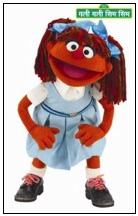"Out beyond ideas of right and wrong there is a field. I'll meet you there." -Rumi In the subcontinent, there is really only one religion that unites India, Pakistan and Bangladesh: cricket. With India’s...
KEEP READINGThe CPD Blog is intended to stimulate dialog among scholars and practitioners from around the world in the public diplomacy sphere. The opinions represented here are the authors' own and do not necessarily reflect CPD's views. For blogger guidelines, click here.
India Blog Series: Sesame Workshop and a New Generation of Citizen Diplomats
APDS Blogger: Maya Babla
Sesame Workshop has 30 international co-productions with 120 other localized versions of the program. Episodes of the local Sesame Street are broadcast around the world, addressing issues ranging from religious tolerance in Pakistan to health and hygiene in Bangladesh. Sesame Workshop provides a top-notch creative model for addressing the Millennium Development Goals, and for conducting public diplomacy. But the real significance of this program is that it appropriates the power of citizen diplomacy to the youngest of the youth population.
In a country like India, with 160 million children under the age of six, this is no small feat, and it’s a unique means of empowering a new generation of citizen diplomats.
In India, Galli Galli Sim Sim, the Hindi Sesame Street launched in 2005, a co-production with Turner Entertainment Networks Asia. Today it is broadcast on Cartoon Network and Pogo throughout the country. The show features Muppets, music, and stories that are uniquely Indian, though an initial feasibility study for the show was funded by the United States Agency for International Development (USAID). According to Shari Rosenfeld, International Vice President for Sesame Workshop, the process of localizing content begins with “curriculum seminars” in which educators and those from the creative community are brought together to decide what areas of focus the show will have.
Hallmarks of Galli Galli Sim Sim are its catchy theme song, which is distinctly Indian as music is woven into nearly every aspect of the culture, as well as the show’s emphasis on diversity. According to Patricia Harrison of the Corporation for Public Broadcasting, the content seeks to “build bridges among different geographical regions, religions, and castes,” as well as fill a gap in teaching “the basic life skills needed to succeed in India today.” For children living in the slums with little access to media, their understanding of the tremendous diversity within their own country may be limited. Sesame Workshop shows function in much the same way that exchange programs do, humanizing a once-foreign people and making the idea of hating someone different from them a lot tougher to do. Significantly, these shows are reaching preschoolers and kindergarteners, not typically the target of exchange programs—but whose hearts and minds are equally worth winning with messages of mutual respect and tolerance.
 The star of Galli Galli Sim Sim, Chamki, who wears her school uniform to send a message of the importance of education for girls
The star of Galli Galli Sim Sim, Chamki, who wears her school uniform to send a message of the importance of education for girls
What I find fascinating about Sesame Workshop in India is that the initiative is multi-platform, and engages in a “three-hundred and sixty degree strategy to reach children between the ages of zero to eight, especially those that are disenfranchised and under resourced.” According to a press release by a new corporate partner, Qualcomm, “Independent third party research commissioned by Galli Galli Sim Sim indicated that children who are exposed to the initiative’s interventions demonstrate greater gains in educational and developmental outcomes than those who are not.”
I think the secret to its success is its comprehensive approach. Mobile community viewings create an opportunity to reach kids who otherwise lack access to media, and whose mothers might otherwise be wary of attending public forums. Both problems are solved when the TV comes to one’s doorstep, and with interactive features to boot. And it doesn’t stop there. Qualcomm’s new partnership with Sesame Workshop India takes community engagement a step further by combining community radio with mobile phone technology to increase access even further.

“Only by leveraging technology and brains can India deliver a truly better life for its masses,” said Tom Friedman in a recent New York Times op-ed. My addendum: the fulcrum must be education for all. The masses of India themselves have the capacity to be a tremendous force sustaining India’s growth. If offered the opportunity at education, they represent the future of an engaged and empowered Indian citizenry, and one that is certain of its strength in the world. It’s this Indian public that will speak for their country’s leadership and innovation, representing India as a new force of citizen diplomats.
The India: Inside Out team is looking forward to talking with Sashwati Banerjee, Executive Director of Sesame Workshop India. Stay tuned to www.indiapublicdiplomacy.com for our reports from that meeting.
Maya Babla is leading the India: Inside Out project. She is a candidate for a Master's in Public Diplomacy, graduating in December.
Visit CPD's Online Library
Explore CPD's vast online database featuring the latest books, articles, speeches and information on international organizations dedicated to public diplomacy.
POPULAR ARTICLES
-
March 22
-
April 11
-
April 1
-
March 4
-
March 19
Join the Conversation
Interested in contributing to the CPD Blog? We welcome your posts. Read our guidelines and find out how you can submit blogs and photo essays >.













